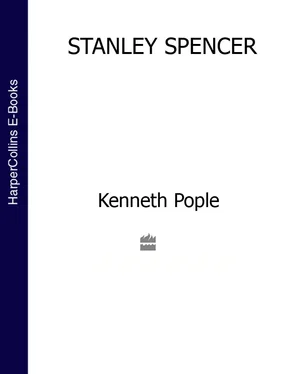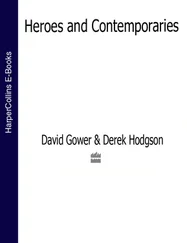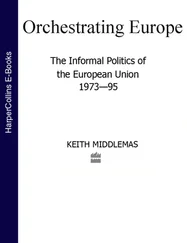The fairy too was drawn from life. Her name was Dorothy Wooster (Worster). She and her sister Emily were cousins and had been school pupils with Stanley and Gilbert. But the significant fact about Dorothy was that Stanley was boyishly attracted to her, as was Gilbert to Emily, despite their father, the local butcher, being parentally suspicious of the young Spencers’ interest in his daughters.
Stanley’s patron had evidently asked for a drawing showing the love of a prince for a fairy. His method of imagining it was to assemble from his own experience images with which he could reproduce the emotion of that theme. The prince was in love with his fairy; he, Stanley, was in love with Dot. So he simply draws her in the situation, buoyant and beautiful because she is loved. The fact that she would sink like a stone was irrelevant: to Stanley the reality of the imagery is subservient to its emotion. However, Stanley admits that the fairy would be small, so he diminishes her by extending the wheat-stalks on the left. There would be water, so what better location than one eventful in his boyhood memory, a little sandy beach by the bank of the Thames where, Florence tells us, all the Spencer children loved to play when young. Simple, one might say, almost ‘primitive’.
But there is in the drawing a curious detail. In the top left, three flowers or marsh plants are reflected as though on the surface of a pond. In many future paintings we shall find similar detail inserted apparently randomly. Yet its presence can change the entire emphasis of the work. In this case, it suggests that Stanley has turned the smooth surface of the pond from the horizontal to the vertical, so that it becomes a reflecting plate-glass window. The world beyond it is enchanted, its apprehension as intangible as the world Stanley entered when he heard fine music played; the flower reflections have taken the form of musical crochets. The fairy is an emanation from that world, but when the magic ends must return to it. The prince, being of the ‘real’ world, cannot enter that land. Stanley ruefully confesses in his letters that he never had great success with the village girls – ‘buds’ to him – and his anticipation at walking and talking with them was invariably disappointed when they failed to match his soaring expectations. Still, he was asked for a drawing of love, and so his love for Dot, which is the love of the prince for the fairy, which is the theme of love in the drawing, becomes a transcendence of the physical into that magic state Stanley cannot yet attain but which he knows to be the spiritual, ‘heaven’.
The authoress rejected the drawing. Its heavy, earthy presentation failed to meet the ethereal romanticism she evidently expected. She must have been as puzzled and offended by it as Stanley was puzzled and disappointed at its rejection. The two minds simply did not meet. In July 1919 he gave it as a wedding present to Ruth Lowy, whose family lived near Cookham. She and Stanley often travelled together on the train to London and the Slade, and she had bought some of his early work. Neither Ruth nor her husband, Victor Gollancz, could understand why Stanley had selected it as a gift. They asked him what it meant. Stanley was again disappointed. It did not, he told Gollancz, mean anything: ‘I do not know that my picture is called anything. The lady on the waterlily leaf is a fairy if you please, and of course the boy on the bank is Edmunds, but honestly I do not know what the picture is all about. You might give the persons depicted a different name for every day in the week with special names for High days and Holidays.’ 5‘I was loving something desperately,’ he was to say of these years, ‘but what this was I had not the least idea. I took the first thing I came to and proceeded to draw it.’ His drawing, an honouring of the dawning in his awareness of the miracle of love, derived from deep personal feeling, still unclarified. He meant the figures to be universal. Was this not apparent? Did he really have to spell it out? How could he?
CHAPTER THREE
John Donne Arriving in Heaven
God will speak unto me, in that voice and in that way, which I am most delighted with and hearken most to. If I be covetous, God will tell me that heaven is a pearl, a treasure. If cheerful and affected with mirth, that heaven is all joy. If sociable and conversable, that it is a communion of saints.
John Donne: Sermon CXX , preached at St Paul’s. 1
IT IS NOW 1911. Two Stanleys are emerging. The Stanley in the tangible world is exploring. His schooling, his reading, his discussions, particularly with his sisters as teachers and with his brother Sydney, begin to reveal that world to him at the physical level. The embryonic world-space of childhood Fernlea extends to the wider geography of Cookham village. The magic for Stanley of the one pervades the other. The cowls of the malthouses behind Fernlea rotate in the wind like the eyes of God. The blacksmith’s anvil rings like the cries of the damned in Dante’s Inferno. Known possessions of villagers, once treasured, appear miraculously as discards on the village rubbish heap. Builders mysteriously carry ladders to unseen destinations. Swans are caught, carpet-bagged for their annual marking, and trundled astonishingly down the High Street in wheelbarrows. Summer steam-launches disgorge hordes of excursionists on to the riverside lawns of the Ferry Hotel, beings as remote to Stanley as those who come for the annual regatta, effete young sprigs in boaters and blazers who lose their punt poles in the river, or fiercely athletic men who swim and row, both with elegant women in tow, whose new, less corseted Paris fashions startle: ‘In Cookham the idle rich have been having some sort of competition for the best bosoms and busts. Ladies patrol the streets boneless utterly. There is one thing, they keep the dogs from barking.’ 2
His family-feeling, the reciprocity of home, is tentatively projected outwards to the places and people of Cookham. The places become inwardly, privately, his. But many of the people are too individualistic to be absorbed. Sometimes he achieves response from them, often not. He views them occasionally with passion, frequently only in amusement or sardonically. If they are to be absorbed, they must die for him in their material form and be reborn as emanations from the place-meanings Cookham holds for him.
Places in Cookham mean specific spots – meadows, riverbanks, trackways, copses – in which he finds, or suddenly found, an ecstasy of sensation. He does not know why they bring such ecstasy, he only knows the sensation to be joyous and to spark creativity.
We swim and look at the bank over the rushes. I swim right in the pathway of sunlight. I go home to breakfast thinking as I go of the beautiful wholeness of the day. During the morning I am visited, and walk about being in that visitation. Now everything seems more definite and to put on a new meaning and freshness. In the afternoon I set my work out and begin my picture. I leave off at dusk, fully delighted with the spiritual labour I have done. 3
Always the drawing came first. When he begins at last to paint – Two Girls and a Beehive (1910) is thought to be his first – he sometimes makes a preliminary wash to test the compositional effect. Then he often measures a pencil grid across the drawing with draughtsman’s exactitude. He covers the canvas with the equivalent grid scaled up and sketches the outlines of the drawing in their co-ordinated positions on the canvas. Working usually from one side or corner, he almost blocks in the paint to create solidity of form. In early paintings the paint is applied thickly, but later, in the heat of passion, sometimes so thinly that the underlying outline shows through or is reinforced. Oil was his favoured medium. He was virtually self-taught in its use, and later claimed that at the Slade he was given only three or so days’ painting tuition, working on a single model: ‘three days out of four years!’
Читать дальше









![Brian Thompson - A Monkey Among Crocodiles - The Life, Loves and Lawsuits of Mrs Georgina Weldon – a disastrous Victorian [Text only]](/books/704922/brian-thompson-a-monkey-among-crocodiles-the-life-thumb.webp)


